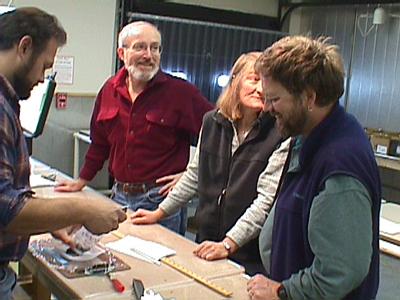
|
|
17 October, 1999
I expected my second day in Antarctica to be a day to look around,
see where things are in "Mactown", as McMurdo Station is called to it's
residents and relax a bit. After a nice nights sleep (we covered the windows
because it was pretty light all night.), I got up, went to breakfast at the
cafeteria then walked over to Crary Lab. Then it happened.....Science Broke
Out! As I was getting settled in the Cape Roberts Section of Crary I heard
some one call "We've got core!" What followed was a scurry of activity and
excitement similar to kids following an ice cream truck. It turned out that
some early core samples were obtained from the drilling off Cape Roberts and
were flown in by helicopter. They have drilled about 120 meters into the sea
floor already, but these were the first samples that have been returned.
These early samples were quite unexpected and gave the scientists lot's to
do. The samples were brought to a receiving area and the various scientists,
including sedimentologists, palynolgists, marine biologists and various
other paleontologists, had their first chance to examine the core sample.
(See picture below.) The big question that needed to be answered was "What
is the age of the sample?" This is critical to the whole project.
The Cape Robert's Project is a 3 year drilling project where
scientists are looking at sediments and rock form the bottom of the Ross Sea
off the coast of Antarctica. One of the purposes of this project is to
reconstruct the geologic history of the area around Antarctica, parcticularly
the Transantarctic Mountains. Each year of the project drilled in a
different location. Each location was selected so the rock at the bottom
(therefore the oldest) of the first drill hole would be about the same age
as the rock at the top (therefore the youngest) of next years drill hole. In
this way, the geologists can construct a continuous rock record from the age
of the rock at the top of the first drill hole to the bottom of the last
drill hole. In order to do this correlation there must be some overlap in
the core samples. The scientists looking at the core are hoping the first
samples they get this year are the same age as the last ones they got last
year. One of the best ways to determine the age of rocks is by looking at
the fossils the rocks contain. Plants and animals have evolved and charged
over time so each aged rock has a unique collection of fossils. The most
numerous fossils in the sediments on the bottom of the Ross Sea are
microfossils. These types of fossils evolve relatively quickly so they can
be used to date sediments fairly accurately. Dr. John Wrenn is a specialist
in using a specific type of microfossils, palynomorphs, to determine ages.
As the samples came in, I assisted John in processing these samples so he
and other paleontologists could study them.
So, I spent most of the day in the lab. I loved it! It was really fun to see
these scientists get so excited about the work and I felt good about being
able to contribute to the process. And, I had a great view outside the lab
window of Mt. Discovery and Mt. Morning. (See picture below.) (Note: For
general background on the Cape Roberts Project, see the beginning of my
homepage or http://www.antarcticanz.govt.nz/crp/CRP.html.)
It was a beautiful day at McMurdo today. It was partly cloudy with a high
temperature of 14 degrees Fahrenheit. It was a bit windy, with wind chill as
low as -35F. Today was Sunday so a lot of people whom work in McMurdo took
walks, went skiing and other excursions. I will be doing the same as soon as
I get the chance, but for now "We've got core!".

The view out the window at Crary Lab of Mr. Discovery and Mr. Morning.

The palynologists, John Wrenn, Rosemary Askin and Mike Hannah, get their first look at the Cape Roberts samples.
Contact the TEA in the field at
.
If you cannot connect through your browser, copy the
TEA's e-mail address in the "To:" line of
your favorite e-mail package.
|
